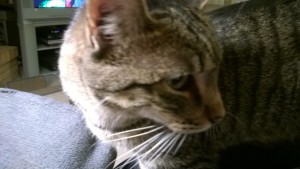The Perils of Cat Hoarding
On suggestion of a friend, I am writing this article in hopes more people become aware of pet hoarding and the dangers it poses to the animals trapped in a hoarding situation.
Let me introduce you to Leela. This is a cat that we adopted from a local cage-free shelter on January 5. Leela was rescued from a cat hoarder along with 44 other cats.
Most of you are familiar with pet hoarding from shows like Hoarders. Cat hoarding is where someone thinks every cat they find is in danger and only they can save it. They feel it’s their duty to provide the cat a home and that they’re doing good by the cat by taking the animal in. The problem being that no one — NO ONE — could possibly have the resources to PROPERLY care for 45+ cats. Hell, most people don’t have the resources to care for more than 3. Maybe 5 or 6 if you have a big house and no kids.
The thing about cats is that they need a few things. First – they’re not dogs. They do require proper feline nutrition. Cats cannot eat people food, so a proper diet of healthy cat food is important. Second – cats need yearly medical exams and have to be taken to the vet when they get sick. This can get pricey if you have a sick cat, but if you properly care for your cat (and keep it indoors if you can), illnesses likely won’t happen until they get older (if at all, though most cats get sick the last 2-4 weeks of their life).
Leela, like the other 44 cats living in the the cat hoarder house, never got proper nutrition, nor did she receive proper medical care. She was rescued from her situation when she was six-years-old and placed in a no-kill, cage-free shelter where she, again, roamed free with another 40+ cats. Leela had limited human contact and was more used to being around other cats than people. People were simply something in the background to her partly feral cat-life. She was in this shelter for 8 months before she came to us. Someone had loved her once because she arrived at the shelter already spade.
Leela picked us out of all the people who came into the shelter. She immediately got my husband’s attention. She tolerated us petting her and giving her some love, and even though she wasn’t an overly friendly cat, she didn’t ignore us like most of the cats in the shelter. After about an hour of wandering around the shelter and asking questions about various cats, we were ready to adopt. Leela was one of our two choices.
We had to fill out paperwork and go through an interview to make sure our home was a fit for both of the independent cats we’d chosen. Everything was fine until the woman doing the final “check out” with us said she was going to send Leela home with some antibiotics because she had some “watery stool”. I was no stranger to this and everything seemed on the level, so we went and brought our kennels in. The first cat went into the kennel just fine. When they put Leela in the kennel, she turned into a wild animal, snarling, growling, spitting, and clawing and biting at the cage.
I still didn’t think anything of it since I’ve yet to meet a cat who enjoys being kenneled without a pitiful howl. So I took them home, sequestered both kitties to a room with some food and water, and let them loose. The younger cat hid for about 6 hours, but after that, she wanted to wander around the house and we saw no problem with that. She adjusted to her environment almost immediately. Leela, on the other hand, stayed in the basement for the first three days she was here. She didn’t just have loose stool. She was suffering from severe diarrhea. The poor thing was also terrified. When she finally did come upstairs, she began defecating all over the floors. Again, having had cats most of my life, this wasn’t a huge upset. I own several carpet cleaners.
I immediately realized Leela needed more adjustment time, so I waited to schedule her initial vet until I felt she was doing a little better, but I had to get her in to get the RIGHT kind of antibiotic for diarrhea, which wasn’t the bubblegum flavor amoxicillin the shelter sent us home with. The fist time I caged Leela and took her to the vet I was torn up pretty bad (kitty has claws) and Leela was shaken up. But when I brought her home she wasn’t too bad. She still hid behind the couch most of the time and came out to see me when things were quiet. She let me pet her and would sometimes sit on my lap.
Where the first cat had a clean bill of health except for some food allergies, Leela’s first wellness visit revealed she had bigger problems. Seven years of little medical intervention except the basics had left her with a mouth full of bad teeth and a painful condition where her body was literally attacking her teeth. I was told I needed to get her in to have a couple of teeth removed and that her hiding behavior and diarrhea could all be related to the pain of her bad teeth.
I’d had older cats with teeth issues before and knew how many problems a bad tooth or two could cause, so I agreed to bring Leela in again, but we wanted to give her a month at home to adjust before taking her back in. We waited. Meanwhile we medicated in hopes of getting the chronic diarrhea under control. Neither thing happened. While I was able to medicate Leela through her food somewhat successfully, Leela would not allow me to catch and medicate her. She did not tolerate being handled much at all, unless it was on her terms. Anything that seemed like confinement was off limits. Over the next few weeks, Leela did not really become more adjusted at all, and two courses of antibiotic did nothing. I began switching out foods and realized her diarrhea was likely food related. But by this time, it was time to take Leela to the vet again to have the bad teeth pulled.
It took me a lot of plotting to get Leela in the cage. I tried catching her with food, failed and finally ended up catching her when she jumped up to sit on my lap. Trust shattered. I’d used our sacred quiet time to put her in the cage and take her to the vet because it was the only way I could catch her for her own good.
Once the vet got into Leela’s little mouth she found 13 bad teeth – not just the two she initially thought she’d have to remove. Leela had been running around in horrible pain, long before she came under our care, and no one noticed, or didn’t care, that she was suffering. Even the people at the shelter had missed it (or couldn’t afford to deal with it).
Once I got Leela home from her dental appointment she immediately hid and would not let me touch her. Again, I couldn’t orally medicate her and had to place her medication in her food. She finally took the medication in tuna the second day, when she finally started eating again. I had to wrestle her into submission the day after the surgery to get the bandage off her leg from the IV they used to put her under for the surgery. She’s been in hiding ever since. All the work and trust building we spent the first month doing has been lost and we’re back at square one with Leela. It’s not that she’s a bad cat or even that she’s an unfriendly cat. She’s simply not a trusting cat and while she wants to be loved (as I suspect she was once a loved animal companion who lost her home for whatever reason before she ended up at the cat hoarder’s house), she hates being kenneled and she’s practically feral, making taking care of her medical needs rather difficult.
This is the cold hard reality of cat hoarding. Cats in hoarding situations can suffer from chronic illnesses, poor socialization (with people) and it can make re-homing them difficult too. I cannot imagine a family who’d never had a sick cat trying to care for a cat like this. Or new cat owners dealing with a cat defecating all over their house. Had we been any other people, poor Leela might have found herself back at the shelter. Re-homing older cats is hard enough, even worse when they’re partly feral. The only way we could possibly make Leela easy to catch and care for medically would be to lock her up in a small room or confined space (like a cage) and to go in and handle her daily — for months. This would severely limit her freedom and who’s to say she wouldn’t revert back to her wild kitty self once released? One thing is for certain — vet visits will always be a challenge with Leela and it will likely take us another month to re-establish any trust whatsoever between her and us after having her teeth removed and the remaining teeth cleaned. It will likely take much longer before she’s not afraid of us walking and talking and moving about the house on a day-to-day basis. I am hoping the food we’ve started feeding will help her digestive tract. Once her mouth is healed and her diarrhea cured, then she can begin healing emotionally and mentally from years of neglect. It’s a long road ahead.
So if you suspect cat hoarding, please report it. No cat deserves to live in an environment where it isn’t properly looked after. People who hoard animals often think they’re doing good and helping the animals, but it’s often the opposite. They’re harming more than they’re helping.



